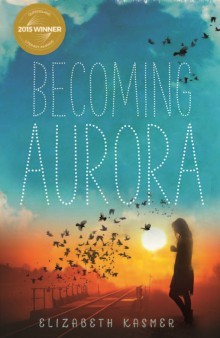What I love about good YA fiction is that the stories remind us of a time in our lives when we struggled with right and wrong, friendships, authority, responsibilities and family, and also because they usually have a positive message; because of this, they are often a joy to read. Elizabeth Kasmer’s debut novel Becoming Aurora is just such a novel. The manuscript won the Emerging Author prize at last year’s Queensland Literary Awards, and the finished work is polished, engaging, life-affirming and heart-warming.
Rory (Aurora) is stuck doing community service because of her part in a racist attack on a restaurant; she runs with the wrong crowd. But she meets Jack, a resident at the nursing home where she is assigned to duties, an old-timer and ex-boxer, who opens her eyes to a certain way of thinking about life. She also meets Essam, a young boxer with a difficult past and a positive attitude towards the future. Her developing relationship with these two men, one at the end of his life, one at the very beginning, begins to shape her own notion of right and wrong, and makes her think about the consequences of her behaviour.
Liz writes with an admirable restraint. Rory’s home life with her mum and little brother Eddie is depicted in spare prose. Not everything is explained or described, but enough detail is provided so that we can see her life situation clearly. Her father has died not too many years earlier; the grief his loss has caused is painful and obvious. Rory’s disturbing dreams of birds are delivered with a light touch. Rory’s friendship with Cam is not overdone, and his character evokes sympathy and understanding despite his actions.
This is a beautiful coming-of-age story that encompasses themes of friendship, blossoming romance, appreciation of the elderly, peer pressure, racism and negative views of asylum seekers, and the ties that bind families. There are no stereotypes in this book: what constitutes a ‘family’ or an ‘old person’ or a ‘boat person’ or a ‘delinquent kid’ are all delivered with depthless shades of grey and multi-faceted layers. There is no judgment, even when you expect it. And there is the beautiful blossoming awakening of compassion.
It is easy as an adult to like this book (I cried at one part), but I put my mind to how an adolescent would respond – would they appreciate it as much? And the answer is a resounding yes. This book will appeal to kids of both genders, and of different backgrounds. This is a story of one girl’s quest to find herself; she is not perfect, but she is trying. And along the way, she makes some new friends and discovers things about herself that she never knew. She grows and becomes stronger. Surely that is a message that all teenagers can relate to: the struggle for identity and self-esteem, the making and breaking of friendships, finding a path through the quagmire of race relations, and of adolescent expectations, dealing with grief and loss, and taking those first tentative steps to leaving childish things behind and becoming a (wo)man. This is a very good book. If you have teenagers, buy or borrow it for them. And if not, read it for yourself.

